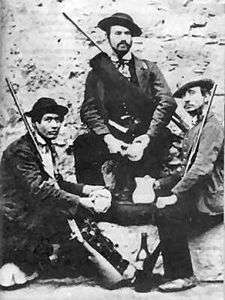Banditry

Banditry is the life and practice of bandits. The New English Dictionary on Historical Principles (NED) defined "bandit" in 1885 as "one who is proscribed or outlawed; hence, a lawless desperate marauder, a brigand: usually applied to members of the organized gangs which infest the mountainous districts of Italy, Sicily, Spain, Greece, Iran, and Turkey".
In modern usage the word may become a synonym for "thief", hence the term "one-armed bandit" for gambling machines that can leave the gambler with no money.[1]
Origin of the word
The term bandit (introduced to English via Italian around 1590) originates with the early Germanic legal practice of outlawing criminals, termed *bannan (English ban). The legal term in the Holy Roman Empire was Acht or Reichsacht, translated as "Imperial ban". In modern Italian the equivalent word "bandito" literally means banned or a banned person.
History

About 5,000 bandits were executed by Pope Sixtus V in the five years before his death in 1590, but there were reputedly 27,000 more at liberty throughout Central Italy.[2]
Marauding was one of the most common peasant reactions to oppression and hardship. The growth of warlord armies in China was also accompanied by a dramatic increase in bandit activity in the republican period; by 1930 the total bandit population was estimated to be 20 million.[3]
Social bandit
"Social banditry" is a term invented by the historian Eric Hobsbawm in his 1959 book Primitive Rebels, a study of popular forms of resistance that also incorporate behaviour characterized by law as illegal. He further expanded the field in the 1969 study Bandits. Social banditry is a widespread phenomenon that has occurred in many societies throughout recorded history, and forms of social banditry still exist, as evidenced by piracy and organized crime syndicates. Later social scientists have also discussed the term's applicability to more modern forms of crime, like street gangs and the economy associated with the trade in illegal drugs.
Nazi Germany
In Nazi Germany, the doctrine of Bandenbekämpfung ("bandit fighting") meant that opponents of the regime were portrayed as "bandits"—dangerous criminals who did not deserve any consideration as human beings. Any opposition was suppressed with maximum force and, usually, the mass murder of civilians living in partisan-controlled areas.[4]
See also
- Bagaudae, bandits around the Pyrenees in the Roman Empire
- Hajduks, bandits in the Balkans
- Sardinian banditry
- Dacoity, Hindi term for banditry
References
- ↑ "bandit, n.". Oxford English Dictionary (Second online version ed.). Oxford University Press. 1989. Retrieved 20 February 2011. — Earlier version first published in New English Dictionary, 1885. (subscription required)
- ↑ Ruggiero, Guido (2006). A Companion to the Worlds of the Renaissance. Wiley-Blackwell. p. 143. ISBN 1-4051-5783-6.
- ↑ Billingsley, Phil (1998). Bandits in Republican China. Stanford University Press. p. 1. ISBN 0-8047-1406-1.
- ↑ Westermann, Edward B. (2005). Hitler's Police Battalions: Enforcing Racial War in the East. Kansas City: University Press of Kansas. pp. 191–192. ISBN 978-0-7006-1724-1.